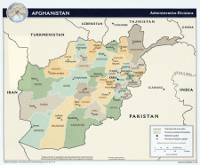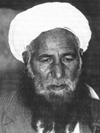During a raid in eastern Afghanistan two days ago, Coalition and Afghanistan special operations forces targeted a leader of the Hizb-i Islami Khalis. The group has links to al Qaeda and the Taliban, and the raid took place in a district of Nangarhar province that has hosted an assortment of terror groups in the past.
A combined Coalition and Afghan force launched an operation in the Khogyani district on Nov. 11. The target of the raid was “a Taliban and Hizb-i Islami Khalis leader,” the International Security Assistance Force said in a press release.
“The leader directs Taliban and HIK militants in the district, as well as facilitates the purchase and movement of small arms and IEDs throughout Nangarhar province,” ISAF stated.
This is just the second time ISAF has announced that it targeted a Hizb-i Islami Khalis commander. The last raid against an HIK leader took place on March 11, 2011, in Jalalabad in Nangarhar. That HIK commander was described by ISAF as being “affiliated with al Qaeda, and facilitates improvised explosive device, and suicide bomber attacks” [see LWJ report, Raid in Afghan east targets Hizb-i Islami Khalis leader, for more information].
The district of Khogyani is known to serve as a hub for groups linked to both al Qaeda and the Taliban. On Dec. 17, 2010, Coalition and Afghan forces captured a Taliban commander who led forces in the district of Khogyani. The commander “led Taliban attacks on district centers, Afghan national security forces check points and coalition force bases” and commanded “a joint Taliban and Lashkar-e-Islam group.” The Lashkar-e-Islam is a Taliban-like group run by Mangal Bagh [for more information, see LWJ report, A profile of Mangal Bagh], who is based in Pakistan’s Khyber tribal agency.
On Nov. 19, 2010, ISAF and Afghan forces captured the top suicide operations facilitator for all of Nangarhar province during a raid in the district. The suicide facilitator was “working for Al Qaeda, Taliban, Haqqani [Network] and other insurgent groups,” according to ISAF. The commander, who was not named, “moved suicide bombers into Afghanistan” from Pakistan.
And in July 2010, Coalition and Afghan forces captured two Taliban commanders who were “directly linked to the Taliban emir of Khogyani district and assisted with the recent influx of Lashkar-e-Taiba fighters into the province” [for more information, see LWJ report, US military begins to link Afghan Taliban to Pakistani terror groups]. The Lashkar-e-Taiba is a Pakistan-based terror group that is allied with both al Qaeda and Pakistan’s military and intelligence service.
Al Qaeda, Hizb-i Islami Khalis, and allied Pakistani terror groups such as Lashkar-e-Taiba, Lashkar-e-Islam, and the Movement of the Taliban in Pakistan all maintain a presence in Nangarhar province, according to an investigation by The Long War Journal. The presence of terror cells has been detected in the districts of Achin, Bati Kowt, Behsud, Chaparhar, Dara Noor, Deh Bala, Hisarak, Jalalabad, Khogyani, Pachir wa Agam, Sherzad, and Shinwar, or 12 of Nangarhar’s 22 districts.
Background on the Hizb-i Islami Khalis
|
|
|
Maulvi Mohammed Yunis Khalis, the founder of the Hizb-i Islami Khalis. |
The Hizb-i Islami Khalis was founded in 1979 by Maulvi Mohammed Yunis Khalis, who broke with Hizb-i Islami leader Gulbuddin Hekmatyar to form his own party. Based in the vital eastern province of Nangarhar, which borders Pakistan, HIK was one of the seven major mujahideen groups that battled the Soviets during the 1980s and were collectively known as the Peshawar Seven. Jalaluddin Haqqani, the leader of the Haqqani Network, which is also closely tied to al Qaeda, was one of Khalis’ top three commanders.
After the Soviet withdrawal in 1989, Khalis cooperated with the interim government, but then quietly supported the Taliban takeover of the country. Khalis was instrumental in welcoming leader Osama bin Laden to Afghanistan after al Qaeda was ejected from Sudan in 1996. The US government said that Khalis helped Osama bin Laden escape from al Qaeda’s stronghold in the Tora Bora mountains during the US operation there in 2001.
Khalis died on July 19, 2006, according to his son, Anwarul Haq Mujahid.
After his father’s death, Mujahid took control of the HIK and created a military group known as the Tora Bora Military Front, which operates in Nangarhar and has been behind a series of deadly attacks in the province. Pakistan detained Mujahid in Peshawar in June 2009. Prior to his detention, Muhajid served as the Taliban’s shadow governor of Nangarhar.
Mujahid is now out of Pakistani custody. On Feb. 8, Mujahid spoke at the funeral of Awal Gul, a former Guantanamo Bay detainee who was captured by US forces in 2002 and died at the facility of natural causes on Feb. 1 of this year.










4 Comments
On Feb. 8, Mujahid spoke at the funeral of Awal Gul……
Hmm, so bad guys gather together so they can bury their dead at funerals? Who would have thought. Lets hope opportunity knocks again.
I wonder how well Hekmatyar & Mujahid get along?
Sounds like all you have to do to understand the war of words and guns in the region — is create a database consisting of the family tree of each of the tribal groups. Then find the links between the family trees and then their links to the ISI. Then link each name to their business interests, family feuds and mosque. (Then find the links between these and the ISI.)
Then anytime anything happens you can pretty much infer the motive & accomplices just by knowing who the main actors are and what they did.
Its like Tuco said in the Good the Bad and the Ugly. “Every gun has its tune.”
Likely the database was constructed years ago. But some kind of fine tuning has occurred in the last two months. I think its likely that the fine tuning has to do with the interaction between interrogation and the database and the response team. Likely this is the work of Patreaus at CIA as he did the same thing in Iraq.
It doesn’t sound like the ISAF got their man this time because they use the word “targeted” rather than say they got the guy. If so, why would they announce that they missed? After all, it would be no secret to the ISI and their tribal allies as to whether their man had been snatched.
The answer may well be that the story is already two days old. Two days may be outside the window of operational information–but still inside the fear factor window.
The bad guys on the other side of the border have to know that every trusted guy they send across the border is not only a gun that points at the ISAF but also a gun that points at the tribal leaders –but not so much at the ISI who get to play this game at no cost to themselves.
This may be why you hear Hafiz Gul Bahadar and
Hakeemullah Mehsud complaining so loudly to the ISI. After all they’re doing all the fighting and dying. They can plainly see that something has changed on the other side because they can see their men being captured and killed at a faster rate.
Again, why are the Haqqanis silent? (This may be that they have stronger business interests in Afghanistan.)
So the subtext of the ISAF PR goes something like this. “Hello. We missed your guy. But don’t count us missing him next time. Chances are he is lethal to you now. Don’t trust him, even if he is innocent.
And this will be true because when the guy is caught, even his lies will lead back to his bosses. So its better that he be killed. They’ll strap a suicide vest to the poor man.
Sheesh no wonder everybody hates the ISI. No wonder all these people have such black looks on their faces. Nobody has their backs.
Bin Laden was the exception. He was the moral center of ISI loyalty. And they could not protect him. That’s what the bitter raids on Kabul have been about over the last couple months. They have not been about strategy or even tactics. They have been about the ISI looking for retribution–but more importantly — to be seen looking for retribution.
The real question this year has been was the ISI loyalty to al queda just a matter of personal loyalty to Bin Laden. (Or –to mean the same thing — payment to Saudis for their money.) Or was the the ISI loyalty to al queda and institutional loyalty.
There is growing evidence that the ISI loyalty to al queda was a matter of personal loyalty to bin laden –rather than institutional loyalty.
With the passing of Bin Laden, the ISI is freed from the constraints of ideology and Saudi money to think of better revenue sources–like minerals.
In this brave new world the ISI would want to be like Saudi Aramco. They would want to generate their own money. They would want to be real big businessmen on the world stage–and not just mafia guys doing stickups extortions and protection for petty cash.’
I could go on but I’m starting to feel sorry for Hafiz Gul Bahadar and Hakeemullah Mehsud and their families.
Good thing they are hard men ruling a hard people. They have placed themselves and their families in a hard place for reasons they no longer understand themselves.
Charles, excellent analysis. Let’s hear more. Maybe we should regard classic islamic treachery as we do western soap operas, ouitgrowths from the depths of our different cultures. Ours is pretend entertaimnet, theirs is viciously acted out in real life-and death with subhuman motives. Thanks.